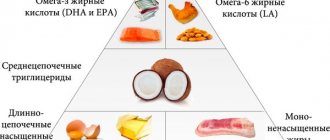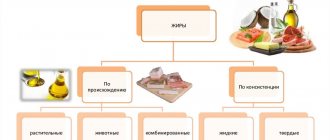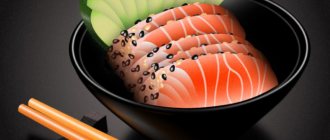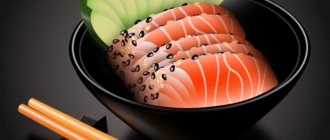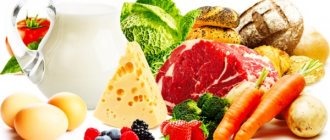Fats (triglycerides) include organic compounds of natural origin, presented in the form of esters, consisting of trihydric alcohol glycerol and monobasic higher or medium fatty (saturated) acids. The reaction of the trihydric alcohol glycerol with carboxylic acids results in the formation of fats.
According to their state of aggregation, fats are solid - of animal origin, with the exception of fish triglyceride, and in the form of an oily liquid, oil obtained from vegetable raw materials. They combine glycerol and higher unsaturated acids.
Triglycerides are an integral part of the cell membrane, belong to the main group of substances, and have a high energy value. One gram of fat releases about 38 kilojoules of energy. Functions of fats:
- construction function: participate in the construction of cells; due to its structure, it is an indispensable material for living organisms;
- energy function: one gram of the substance contains 9 kilocalories of energy, subcutaneous fat is the main nutritional source during the fasting period, they nourish the striated muscles, liver, kidneys;
- protective function: fat located under the skin is a heat-insulating shell; internal fat protects internal organs;
- storage function: able to maintain a feeling of fullness for a long time due to the fact that they are slowly digested.
Together with carbohydrates and proteins, fats belong to the main group of important components. They are part of organisms of animal origin and plants. Dissolves only in ether, chloroform, benzene, and hot ethanol.
What are fats
The scientific concept of fats (lipids) implies a combination of all kinds of fat-like substances. In biology, the definition is as follows: fats are complex organic compounds that have different internal structures, but similar properties.
What types of fats are there?
Types of fats by appearance:
- From vegetable raw materials, these are mainly liquid fats, with the exception of coconut and cocoa bean oil. This type includes all types of vegetable oil (sunflower, soybean, olive, cottonseed, rapeseed, flaxseed and others). The substances contain a lot of unsaturated fatty acids that melt at low temperatures. Easily digestible by humans.
- Animal fats are solid fats other than fish fats. Lamb, pork, beef and other types of fats melt at high temperatures. The substances contain a lot of saturated fatty acids. Animal triglycerides provide energy and increase bad cholesterol levels.
It is recommended not to combine plant and animal triglycerides in food.
Types of fats by fatty acid content:
- Substances with monounsaturated fatty acids (palmitic acid, oleic acid). Necessary for the body because it removes harmful cholesterol. Protect the cardiovascular system from heart attacks, strokes, and atherosclerosis. The body uses monounsaturated fatty acids rather than storing them in reserve in the subcutaneous layer. Such acids are found in olive, rapeseed, peanut, sunflower oil, avocados, olives, and nuts.
- Substances with polyunsaturated fatty acids: linoleic - Omega 6, alpha-linoleic - Omega 3, eicosapentoenoic - EPA, docosahexaenoic - DHA, conjugated linoleic - CLA. Needed by a person to protect the heart. They also promote the growth of muscle tissue. The most useful products with Omega 3 are fish (red fish, herring, sardines, tuna), flaxseed oil, hemp oil, and nuts.
- Substances with saturated fatty acids (palmitic, stearic, lauric). They increase cholesterol levels and contribute to the formation of excess deposits under the skin if consumed together with carbohydrates. When used correctly, they promote the production of testosterone and increase muscle endurance. Sources of saturated fatty acids: beef, poultry, pork, lard. Dairy products, chocolate, coconut and palm oil are rich in them.
- Trans isomers of fatty acids (trans fats). The industrial way of creating margarines is called hydrogenation, when vegetable fats are saturated with hydrogen. The use of trans isomers in nutrition causes problems in the functioning of the heart and blood vessels, risks diabetes, and reduces muscle volume. Fast food is made on the basis of margarines. They are most used in the production of chips, crackers, donuts, crackers, candies, cakes, and cookies. There are a lot of trans fats in mayonnaise, ketchup, instant soup, French fries, in all fried foods, in fast food.
What are the types of fats - classification
Classification of the composition and structure of triglycerides is difficult due to the abundance of substances. They are united by hydrophobicity, that is, the ability to not dissolve in water. Depending on how the substance interacts with water, fats can be saponified or unsaponifiable.
- Saponified triglycerides contain at least two structural components. Their components: alcohols, higher fatty acids. More complex structures also include phosphoric acid, amino alcohols, mono- and oligosaccharides. When hydrolysis occurs under the action of acids, alkalis or lipase enzymes, it breaks down into components.
- Unsaponifiable triglycerides do not result from the combination of fatty acids and are therefore not subject to hydrolysis. These are natural compounds united by a similar base structure. The carbon skeleton of an unsaponifiable fat molecule is made up of isoprene units, with a “head” adjacent to a “tail.”
Composition of fats
Triglycerides are part of plants and animals. Their molecular composition contains higher carboxylic acids: palmitic, stearic, oleic, linoleic, linolenic. Fats contain almost no lower acidic compounds: they are rare. An example is butter: it contains butyric acid.
Structure of fats:
CH2−O−CO−R
I
CH−O−CO−R
I
CH2−O−CO−R
This is the general formula of fats, where C is carbon; H – hydrogen; O – oxygen; R – particles containing one or more unpaired electrons, they are also called carboxylic acid radicals. Particles can be represented by different formulas: C15H31, C17H33, C17H35.
Types of fats
Fats are of vegetable and animal origin.
By consistency - solid and liquid.
Also, all fats that enter the body with food are divided into 3 groups:
- Saturated.
- Unsaturated.
- Trans fats.
Saturated
Saturated fats are so called because they have a simple structure and single bonds between atoms.
These are mainly animal lipids that have a solid consistency at room temperature.
They are quickly absorbed and, with a lack of physical activity, are deposited in adipose tissue.
Saturated fats are involved in the production of cholesterol, sex hormones, and regulate heat exchange.
The products in which they are present are nutritious and contain vitamins A, D, and lecithin.
Therefore, they should be consumed, but in limited quantities.
With an excess of saturated fats, cholesterol levels increase and excess weight accumulates.
They increase the risk of developing cardiovascular diseases and diabetes.
I will definitely tell you today about the most rational proportion of fats of animal and vegetable origin.
Unsaturated
Unsaturated fats are found mainly in plant foods and fish.
According to their structure, they have double and triple bonds between atoms.
Therefore, such lipids are easily oxidized in air and destroyed during heat treatment.
Unsaturated fatty acids are called Omega 3, Omega 6 and Omega 9.
Remember I wrote a cool and detailed article about flaxseed oil and fish oil?
These fats are divided into monounsaturated and polyunsaturated.
- Monounsaturated are Omega 9. They can be produced in the body, so they are not essential. These acids strengthen the immune system, normalize the absorption of glucose, reduce cholesterol levels, and accelerate metabolic processes. But if consumed in excess with food, they can accumulate.
- Polyunsaturated Omega 6s have more bonds between atoms. They are considered essential because they are not produced in the body. They perform important functions: improve skin condition, relieve inflammation, normalize blood clotting.
- Omega 3 polyunsaturated acids enter the body only with food. They are the most useful and necessary for the normal functioning of all organs. These acids strengthen cell membranes, accelerate regeneration processes, and improve the functioning of the nervous, reproductive and immune systems.
Trans fats
It is a type of saturated fat that has been artificially modified and processed. I gave you a link to an article about this type of fat above. Be sure to read it.
You can't use them!
They are very harmful to health, as they increase cholesterol levels (specifically, “bad cholesterol” LDL), worsen metabolism, and increase the risk of obesity and cardiovascular pathologies.
It is not recommended to consume products containing them. They lead to increased insulin synthesis and accumulation of fat cells.
The role and functions of fats in the human body
The role of fats in the human body is significant. They perform several vital functions for humans. The importance of fats in the body is evident from their participation in the work of various organs.
- The main function of fats is energy. A person receives most of their energy from carbohydrates; triglycerides contain reserve energy, which is required in case of a lack of carbohydrates.
- Fat-soluble vitamins A, D, E, K move, dissolve, and are absorbed due to the transport function of triglycerides.
- Subcutaneous fat is stored as an energy reserve and is used when there is a deficiency of nutrients, so triglycerides have a storage function.
- Triglycerides are a good heat insulator that protects against hypothermia. They have a thermal insulation function.
- The protective function of triglycerides helps protect human organs from harmful mechanical influences.
- Structural function. Triglycerides are the building blocks of cells.
- Regulatory function. Triglycerides help regulate the production of steroid hormones necessary for metabolism, reproductive organs, and the immune system.
Therefore, it is necessary to know the importance of fats for a person so as not to give them up completely. What are triglycerides needed for? For proper, full functioning of the body.
What do healthy fats mean?
Healthy triglycerides contain monounsaturated fatty acids: palmitic, oleic, and polyunsaturated fatty acids: linoleic - Omega 6, alpha-linoleic - Omega 3, eicosapentoenoic, docosahexaenoic, conjugated linoleic. A person gets useful triglycerides from food because the body does not generate them in the required quantities.
We need useful triglycerides for the growth and strengthening of muscles, for the proper functioning of the heart and blood vessels, for strengthening the immune system, for metabolic processes, and for the production of testosterone.
Sources of healthy fats: vegetable oil, avocados, olives, fish, nuts, seeds, olives.
What happens if there is not enough fat?
Since fats are necessary for the normal functioning of all organs and systems, I do not recommend excluding them from the diet.
Low-fat foods and diets are not a panacea, just control the proportion of fat entering the body and you will be happy.
Even when losing weight, you cannot reduce their amount below normal.
This will lead to a deterioration in metabolism and slow down the weight loss process.
Due to a lack of fat in the diet, health problems may arise:
- hormonal imbalances, decreased libido;
- deterioration in performance, lack of energy, increased fatigue;
- decreased skin elasticity, dryness, hair loss and fragility;
- acceleration of aging processes, appearance of wrinkles;
- exhaustion of the nervous system, depression;
- decreased immunity;
- avitaminosis;
- deterioration of mental activity, decreased concentration;
- blurred vision;
- joint pathologies;
- development of gallstone disease.
Is it possible to completely avoid saturated fats?
Lipids are an important component of food and the main source of energy.
Therefore, even saturated fats are essential for health.
You cannot completely abandon them, you just need not to exceed the recommended norms (10% of all fats in the diet). They are especially important for people involved in sports or intense mental work.
Low-fat food does not help you lose weight if the main rule of losing weight is not followed:
Consume less calories than you burn.
Low-fat food is less tasty, less satiating and leads to a decrease in physical activity if you do not plan your diet correctly.
A lack of saturated fats can cause hormonal imbalances, deterioration of immunity, and decreased vascular elasticity. And in low-fat dairy products, calcium absorption deteriorates.
Therefore, saturated fats are also useful, foods containing them should be included in the diet daily.
I will say for the third time that you should only avoid trans fats, which do nothing but harm the body.
Foods rich in fats
Triglycerides are of animal and plant origin. Information about where one of the main substances is contained and in what volumes makes it possible to balance the diet.
Plant foods rich in fats:
| Product name | What type of fatty acids predominates? | Content per 100 g (in grams) | Content in 100 g (%) of the norm | Share of fats in calories |
| Avocado | monounsaturated | 14.7 | 21.6 | 0.9 |
| Walnuts | polyunsaturated | 65 | 96 | 0.87 |
| Almond | monounsaturated polyunsaturated | 54 | 79 | 0.79 |
| Pistachios | monounsaturated polyunsaturated | 45 | 67 | 0.74 |
| Pine nut | monounsaturated polyunsaturated | 68 | 100.6 | 0.87 |
| Peanut | monounsaturated polyunsaturated | 49 | 72 | 0.77 |
| Hazelnut | monounsaturated | 61.5 | 90.5 | 0.85 |
| Olive oil | monounsaturated | 100 | 147 | 1 |
| Peanut butter | monounsaturated polyunsaturated | 50 | 73.5 | 0.72 |
| Rapeseed oil | monounsaturated | 100 | 147 | 1 |
| Sunflower oil | polyunsaturated | 100 | 147 | 1 |
| Linseed oil | polyunsaturated | 100 | 147 | 1 |
| Hemp oil | polyunsaturated | 100 | 147 | 1 |
| Olives | monounsaturated | 15 | 22.5 | 0.96 |
| Flax seeds | polyunsaturated | 42 | 62 | 0.83 |
| Soybean fruits | polyunsaturated | 18 | 26 | 0.43 |
| Sunflower seeds | polyunsaturated | 53 | 78 | 0.79 |
| Chia seeds | polyunsaturated | 31 | 45 | 0.54 |
| Dark chocolate | polyunsaturated saturated | 28 | 41 | 0.5 |
| White dried mushrooms | rich | 14 | 21 | 0.45 |
Animal foods rich in fats:
| Product name | What type of fatty acids predominates? | Content per 100 g (in grams) | Content in 100 g (%) of the norm | Share of fats in calories |
| Salmon | monounsaturated polyunsaturated | 8 | 12 | 0.48 |
| Acne | polyunsaturated | 30.5 | 45 | 0.83 |
| Tuna | polyunsaturated | 4.5 | 6.5 | 0.3 |
| Saira | polyunsaturated | 14 | 21 | 0.62 |
| Herring | monounsaturated polyunsaturated | 8.5 | 12.5 | 0.53 |
| Salmon | monounsaturated polyunsaturated | 10 | 15 | 0.52 |
| Sturgeon | monounsaturated polyunsaturated | 4 | 6 | 0.36 |
| Som | monounsaturated polyunsaturated | 5 | 7.5 | 0.4 |
| Gobies | monounsaturated polyunsaturated | 4 | 6 | 0.34 |
| Sturgeon caviar | polyunsaturated | 14.5 | 21 | 0.45 |
| Chum salmon caviar | polyunsaturated | 13 | 19 | 0.48 |
| Pork | monounsaturated saturated | 33 | 49 | 0.84 |
| Beef | monounsaturated saturated | 3.5 | 5 | 0.3 |
| Mutton | monounsaturated saturated | 16 | 24 | 0.7 |
| Rabbit meat | monounsaturated saturated | 11 | 16 | 0.54 |
| Turkey meat | monounsaturated polyunsaturated | 6 | 8 | 0.37 |
| Chicken's meat | monounsaturated polyunsaturated | 2 | 3 | 0.15 |
| horsemeat | monounsaturated saturated | 4.5 | 7 | 0.33 |
| Beef liver | rich | 4 | 25 | 0.26 |
| Pork liver | monounsaturated saturated | 4 | 6 | 0.27 |
| Pork lard | monounsaturated saturated | 93 | 136 | 0.99 |
| Buzhenina | monounsaturated saturated | 27 | 39 | 0.78 |
| Raw smoked sausage | monounsaturated saturated | 47 | 70 | 0.86 |
| Eggs | monounsaturated saturated | 11 | 17 | 0.66 |
| Natural milk | monounsaturated saturated | 4 | 6 | 0.55 |
| Sour cream 15% | monounsaturated saturated | 15 | 22 | 0.85 |
| Tofu cheese | polyunsaturated | 5 | 7 | 0.37 |
| Parmesan cheese | monounsaturated saturated | 25 | 37 | 0.59 |
| Natural yogurt | rich | 3 | 5 | 0.4 |
| Kefir 2.5% | rich | 2.5 | 4 | 0.45 |
| Butter | rich | 82.5 | 121 | 0.99 |
| Mayonnaise "Provencal" | polyunsaturated | 67 | 98 | 0.96 |
| Cottage cheese 5% | rich | 5 | 7 | 0.32 |
Digestion of fats

Since lipids are insoluble in water, the process of their breakdown and digestion in the digestive tract occurs with the participation of special enzymes. Lipase is produced by the glands of the tongue, cellular structures of the pancreas that produce pancreatic lipase.
Bile, bile acids, and pancreatic juice also take part in the digestion, breakdown, and absorption of fats.
Approximately 10-30% of dietary fat is hydrolyzed in the stomach, and the remaining 70-90% is broken down in the duodenum and upper small intestine.
The digestibility of lipids by the body, as well as their nutritional value, depends on their melting point. Fats with a low melting point (35-37 degrees) are more quickly and fully emulsified in the body.
The body's daily requirement for fats
How much fat should you consume per day according to doctors' advice?
The daily fat intake for each person is calculated individually depending on age, physical activity, and health status.
The only rule is that 20-25% of your daily calories should come from triglycerides.
But they should not be more than 30%, because otherwise excess fat will become an unnecessary reserve, weaken the immune system, reduce reproductive function, slow down metabolic processes, and cause chronic fatigue.
- For men aged 18 to 29 years with light physical activity, the daily fat intake is 50 grams.
- For men aged 30 to 39 years with light physical activity, the daily intake is 48 grams.
- For men aged 40 to 59 years with light physical activity, the daily intake is 45 grams.
- For men aged 18 to 29 with average physical activity, the daily intake is 53 grams.
- For men aged 30 to 39 with average physical activity, the daily intake is 51 grams.
- For men aged 40 to 59 years with average physical activity, the daily intake is 48 grams.
- For men aged 18 to 29 with vigorous physical activity, the daily intake is 61 grams.
- For men aged 30 to 39 with vigorous physical activity, the daily intake is 58 grams.
- For men aged 40 to 59 years with vigorous physical activity, the daily intake is 56 grams.
- For women aged 18 to 29 years with light physical activity, the daily intake is 42 grams.
- For women aged 30 to 39 years with light physical activity, the daily intake is 41 grams.
- For women aged 40 to 59 years with light physical activity, the daily intake is 39 grams.
- For women aged 18 to 29 years with average physical activity, the daily intake is 45 grams.
- For women aged 30 to 39 years with average physical activity, the daily intake is 43 grams.
- For women aged 40 to 59 years with average physical activity, the daily intake is 41 grams.
- For women aged 18 to 29 with intense physical activity, the daily intake is 48 grams.
- For women aged 30 to 39 years with intense physical activity, the daily intake is 46 grams.
- For women aged 40 to 59 years with intense physical activity, the daily intake is 44 grams.
In addition to following the correct intake of triglycerides, it is important to maintain a balance between the consumption of Omega 3 and Omega 6 polyunsaturated fatty acids. They should be supplied to the body in equal shares, or Omega 3 may be greater. Stewed, baked or steamed dishes will help with this. The balance between proteins, fats, and carbohydrates is also important.
The importance of fats for the body
All types of fats in the body are responsible for different functions. They are an essential component of a balanced diet and are among the top three macronutrients. The compounds are considered one of the main sources of energy for the body. The energy value of such molecules is approximately two times higher than that of carbohydrates. They are contained in all cells, ensuring the process of dissolving a group of vitamins. The compounds also help the body retain heat and play an important role in the functioning of the nervous system and immunity.
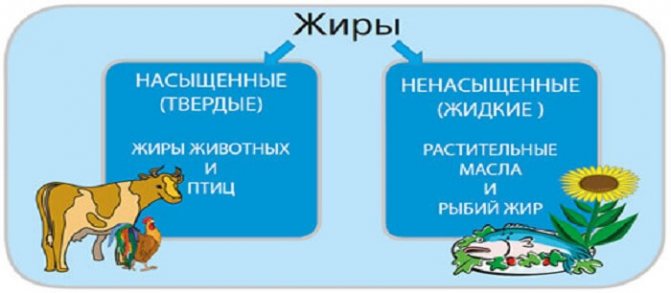
Types of fats
Excess fat in food

An excess of triglycerides in human food leads to the formation of excess deposits - obesity. This negatively affects the body. The consequences may be an increase in blood clotting, the formation of stones in the liver and gall bladder, and deterioration in the functioning of internal organs. Obesity will lead to increased blood pressure, disruption of the heart and blood vessels, thyroid gland, ovaries, negative changes in bone and muscle tissue, and increased cholesterol levels.
Properties of fats
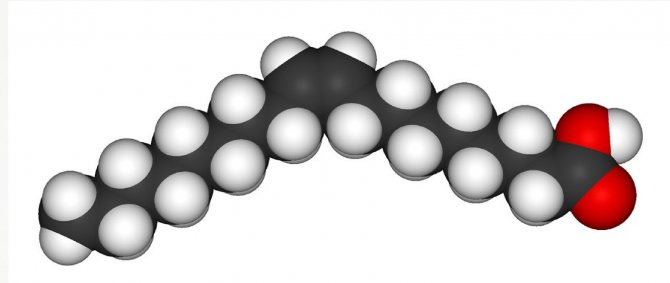
The properties of fats are very similar, regardless of their chemical structure. Lipids are insoluble in aqueous media and are lighter than water. At the same time, viscous liquids and solid fats dissolve well in organic solvents (benzene, ether).
They have physiological activity, have a high molecular weight of the main structural elements, and different melting points.
Digestibility of fats
Scientific research has shown that vegetable and animal fats are absorbed differently. The absorption of plant triglycerides occurs quickly, and energy is also obtained quickly. Animal fats are digested more slowly, which allows you to feel full for a long time.
Statistics show that men prefer fats of animal origin, and women prefer vegetable fats. A person who cares about his health should know why fats are needed. This will help him avoid many diseases and prolong his youth.
Composition of fats
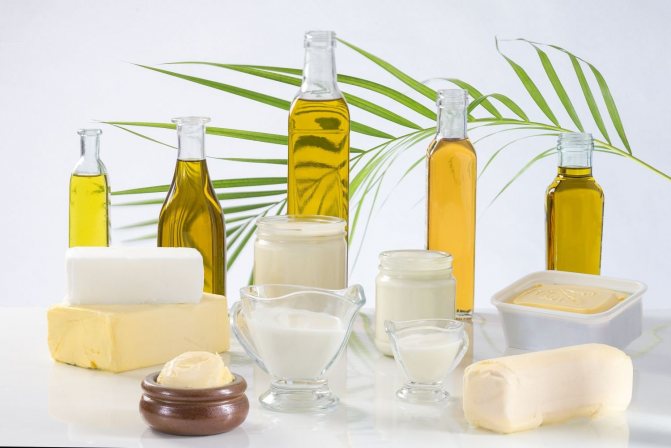
Vegetable and animal fats are not pure chemical compounds. Therefore, the composition of fats may have a different structure.
Lipids do not have precise chemical characteristics, so their classification is based on their biochemical composition, according to their structure:
- complex (containing phosphorus, nitrogen, sometimes sulfur);
- cyclical.
Simple lipids include glycerides (triglycerides), which are the main part of fats. This category also includes cerines, which are part of waxes, microsides, cerols, and fatty hydrocarbons (squalene, terpenes).
Complex lipids include glycosidelipids (compounds of complex sugars, high-molecular fatty acids), phosphatides, which are esters of alcohols, lipoproteins - compounds of proteins with lipids.
Cyclic lipids include lipids that contain components with a cyclic molecular structure, for example, sterols (sterols) and esters (sterides) with high molecular weight aliphatic (or fatty) acids.
Fats are a valuable chemical product, one of the main components of animal and plant cells. This lesson will be devoted to the study of the structure and most characteristic properties of fats.
“Chemistry is everywhere, chemistry is in everything: In everything we breathe, In everything we drink, In everything we eat.”
I. Fats in nature and their role
People have long learned to extract fat from natural objects and use it in everyday life. Fat burned in primitive lamps, illuminating the caves of primitive people; the runners on which ships were launched were lubricated with fat. Fats are the main source of our nutrition. But poor nutrition and a sedentary lifestyle lead to excess weight. Desert animals store fat as a source of energy and water. The thick fat layer of seals and whales helps them swim in the cold waters of the Arctic Ocean.
Fats are widely distributed in nature. Along with carbohydrates and proteins, they are part of all animal and plant organisms and constitute one of the main parts of our food. Sources of fats are living organisms. Animals include cows, pigs, sheep, chickens, seals, whales, geese, fish (sharks, cod, herring). Fish oil, a medicinal product, is obtained from the liver of cod and shark, and fats used to feed farm animals are obtained from herring. Vegetable fats are most often liquid and are called oils. Fats from plants such as cotton, flax, soybeans, peanuts, sesame, rapeseed, sunflower, mustard, corn, poppy, hemp, coconut, sea buckthorn, rose hips, oil palm and many others are used.
Fats perform various functions: construction, energy (1 g of fat provides 9 kcal of energy), protective, storage. Fats provide 50% of the energy required by a person, so a person needs to consume 70–80 grams of fat per day. Fats make up 10–20% of a healthy person's body weight. Fats are an essential source of fatty acids. Some fats contain vitamins A, D, E, K, and hormones.
Many animals and humans use fat as a heat-insulating shell; for example, in some marine animals the thickness of the fat layer reaches a meter. In addition, fats are solvents for flavoring agents and dyes in the body. Many vitamins, such as vitamin A, are only fat soluble.
Some animals (usually waterfowl) use fats to lubricate their own muscle fibers.
Fats increase the satiety effect of foods because they are digested very slowly and delay the onset of hunger.
II. History of the discovery of fats
Back in the 17th century. The German scientist, one of the first analytical chemists, Otto Tachenius (1652–1699), first suggested that fats contain “hidden acid.”
In 1741, the French chemist Claude Joseph Geoffroy (1685–1752) discovered that when soap (which was prepared by boiling fat with alkali) decomposes with acid, a mass is formed that is greasy to the touch.
The fact that fats and oils contain glycerin was first discovered in 1779 by the famous Swedish chemist Carl Wilhelm Scheele .
The chemical composition of fats was first determined at the beginning of the last century by the French chemist Michel Eugene Chevreul , the founder of the chemistry of fats, the author of numerous studies of their nature, summarized in the six-volume monograph “Chemical Studies of Bodies of Animal Origin.”
1813 E. Chevreul established the structure of fats, thanks to the hydrolysis reaction of fats in an alkaline medium. He showed that fats consist of glycerol and fatty acids, and this is not just a mixture of them, but a compound that, by adding water, breaks down into glycerol and acids.
III. Fat synthesis
In 1854, the French chemist Marcelin Berthelot (1827–1907) carried out an esterification reaction, that is, the formation of an ester between glycerol and fatty acids, and thus synthesized fat for the first time.
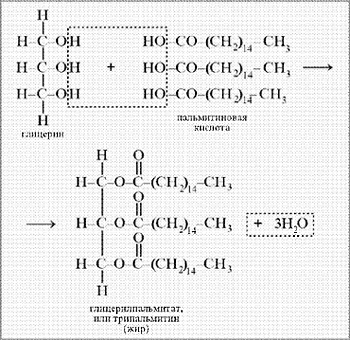
General formula of fats (triglycerides):
Fats are esters of glycerol and higher carboxylic acids. The common name for these compounds is triglycerides.
IV. Classification of fats
Animal fats contain mainly glycerides of saturated acids and are solids.
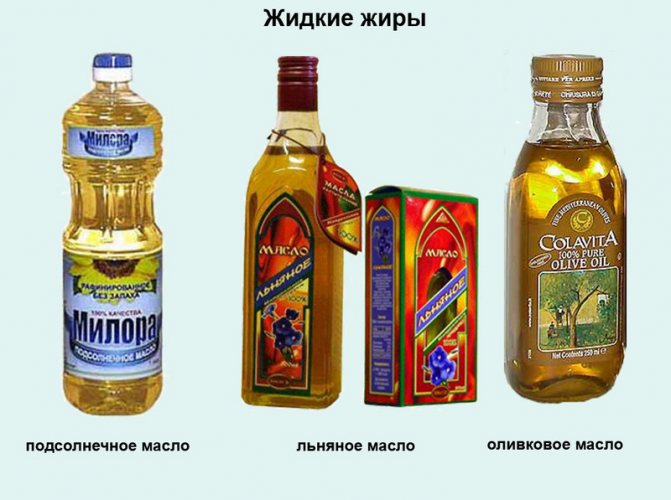
Vegetable fats, often called oils, contain glycerides of unsaturated carboxylic acids. These are, for example, liquid sunflower, hemp and linseed oils.

Natural fats contain the following fatty acids
| Saturated: stearic (C17H35COOH) palmitic (C15H31COOH) oil (C3H7COOH) | Contains animal fats |
| Unsaturated: oleic (C17H33COOH, 1 double bond) linoleic (C17H31COOH, 2 double bonds) linolenic (C17H29COOH, 3 double bonds) arachidonic (C19H31COOH, 4 double bonds, less common) | Contains vegetable fats |
Fats are found in all plants and animals. They are mixtures of full glycerol esters and do not have a clearly defined melting point.

V. Physical properties of fats
At room temperature, fats (mixtures of triglycerides) are solid, ointment-like or liquid substances. Like any mixture of substances, they do not have a clear melting point (that is, they melt in a certain temperature range). Only individual triglycerides are characterized by a certain melting point. The consistency of fats depends on their composition:
- in solid fats, triglycerides with saturated acid residues predominate, having relatively high melting points;
- Liquid fats (oils), on the contrary, are characterized by a high content of triglycerides of unsaturated acids with low melting points.
The reason for the decrease in the melting point of triglycerides with unsaturated acid residues is the presence of double bonds in them with the cis configuration. This leads to a significant bending of the carbon chain, disrupting the ordered (parallel) stacking of long-chain acid radicals. Let's compare the spatial structure of unsaturated and saturated acids with an equal number of carbon atoms in the chain: oleic C17H33COOH and stearic C17H35COOH.

The molecular model of oleic acid shows a chain bend at the C=C bond, which prevents the molecules from packing tightly.

There are no bends in the carbon chain of stearic acid, so its molecules are capable of dense parallel packing.
The denser the packing of the molecules of a substance, the higher the temperatures of its phase transitions (melting point, boiling point). Accordingly, the melting point of glycerol tristearate (71 oC) is significantly higher than that of trioleate (–17 oC).
Fats are practically insoluble in water, but when soap or other surfactants (emulsifiers) are added, they are able to form stable aqueous emulsions. Fats are sparingly soluble in alcohol and highly soluble in many non-polar and low-polar solvents - ether, benzene, chloroform, gasoline.
- Animal fats (lamb, pork, beef, etc.), as a rule, are solid substances with a low melting point (an exception is fish oil). In solid fats, residues of saturated acids predominate.
- Vegetable fats - oils (sunflower, soybean, cottonseed, etc.) - liquids (exception - coconut oil, cocoa bean butter). Oils contain mainly residues of unsaturated (unsaturated) acids.
Video experiment: “Determination of fat unsaturation”
Essential fatty acids
With proper nutrition, approximately a third of the fats consumed by a person should be liquid vegetable fats containing residues of unsaturated acids. Polyunsaturated acids with several double bonds are especially important:
- linoleic CH3(CH2)4CH=CHCH2CH=CH(CH2)7COOH,
- linolenic CH3CH2CH=CHCH2CH=CHCH2CH=CH(CH2)7COOH,
- arachidonic CH3(CH2)4CH=CHCH2CH=CHCH2CH=CHCH2CH=CH(CH2)3COOH
They are the ones that have the greatest biological activity. The human body cannot synthesize such acids and must obtain them ready-made with food. Therefore, polyunsaturated fatty acids are called “essential”.
VI. Chemical properties of fats
1. Hydrolysis, or saponification
Occurs under the influence of water, with the participation of enzymes or acid catalysts (reversible), and alcohol is formed - glycerin and a mixture of carboxylic acids:
or alkalis (irreversible). Alkaline hydrolysis produces salts of higher fatty acids, called soaps. Soaps are obtained by hydrolysis of fats in the presence of alkalis:

Soaps are potassium and sodium salts of higher carboxylic acids.
2. Hydrogenation of fats
This conversion of liquid vegetable oils into solid fats is of great importance for food purposes. The product of oil hydrogenation is solid fat (artificial lard, lard). Margarine is an edible fat that consists of a mixture of hydrogenated oils (sunflower, corn, cottonseed, etc.), animal fats, milk and flavoring additives (salt, sugar, vitamins, etc.).
This is how margarine is produced in industry:

Under the conditions of the oil hydrogenation process (high temperature, metal catalyst), some of the acid residues containing cis C=C bonds are isomerized into more stable trans isomers. An increased content of trans-unsaturated acid residues in margarine (especially in cheap varieties) increases the risk of atherosclerosis, cardiovascular and other diseases.
VII. Application of fats

- Food industry
- Pharmaceuticals
- Production of soap and cosmetic products
- Production of lubricants
VIII. Fats are a food product. Biological role of fats
Animal fats and vegetable oils, along with proteins and carbohydrates, are one of the main components of normal human nutrition. They are the main source of energy: 1 g of fat, when fully oxidized (it occurs in cells with the participation of oxygen), provides 9.5 kcal (about 40 kJ) of energy, which is almost twice as much as can be obtained from proteins or carbohydrates. In addition, fat reserves in the body contain practically no water, while protein and carbohydrate molecules are always surrounded by water molecules. As a result, one gram of fat provides almost 6 times more energy than one gram of animal starch - glycogen. Thus, fat should rightfully be considered a high-calorie “fuel”. It is mainly spent to maintain the normal temperature of the human body, as well as to work various muscles, so even when a person is doing nothing (for example, sleeping), he needs about 350 kJ of energy every hour to cover energy costs, approximately the same power as an electric 100 -watt light bulb .
To provide the body with energy in unfavorable conditions, fat reserves are created in it, which are deposited in the subcutaneous tissue, in the fatty fold of the peritoneum - the so-called omentum. Subcutaneous fat protects the body from hypothermia (this function of fat is especially important for marine animals). For thousands of years, people have performed hard physical work, which required large amounts of energy and, accordingly, increased nutrition. To cover a person's minimum daily energy requirement, only 50 g of fat is enough. However, with moderate physical activity, an adult should receive slightly more fat from food, but their amount should not exceed 100 g (this provides a third of the calorie content for a diet of about 3000 kcal). It should be noted that half of these 100 g are contained in food in the form of so-called hidden fat. Fats are contained in almost all food products: they are even found in small quantities in potatoes (0.4% there), in bread (1–2%), and in oatmeal (6%). Milk usually contains 2-3% fat (but there are also special varieties of skim milk). There is quite a lot of hidden fat in lean meat - from 2 to 33%. Hidden fat is present in the product in the form of individual tiny particles. Almost pure fats are lard and vegetable oil; Butter contains about 80% fat, and ghee – 98%. Of course, all the given recommendations for fat consumption are averages; they depend on gender and age, physical activity and climatic conditions. With excessive consumption of fats, a person quickly gains weight, but we should not forget that fats in the body can also be synthesized from other foods. “Working off” extra calories through physical activity is not so easy. For example, after jogging 7 km, a person spends approximately the same amount of energy as he gets by eating just one hundred gram chocolate bar (35% fat, 55% carbohydrates) . Physiologists have found that with physical activity that is 10 times higher than usual, the person receiving the fat diet was completely exhausted after 1.5 hours. With a carbohydrate diet, a person withstood the same load for 4 hours. This seemingly paradoxical result is explained by the peculiarities of biochemical processes. Despite the high “energy intensity” of fats, obtaining energy from them in the body is a slow process. This is due to the low reactivity of fats, especially their hydrocarbon chains. Carbohydrates, although they provide less energy than fats, “release” it much faster. Therefore, before physical activity, it is preferable to eat sweets rather than fatty foods. An excess of fats in food, especially animals, increases the risk of developing diseases such as atherosclerosis, heart failure, etc. Animal fats contain a lot of cholesterol (but we should not forget that two-thirds of cholesterol is synthesized in the body from low-fat foods - carbohydrates and proteins).
It is known that a significant proportion of the fat consumed should be vegetable oils, which contain compounds that are very important for the body - polyunsaturated fatty acids with several double bonds. These acids are called “essential”. Like vitamins, they must enter the body in ready-made form. Of these, arachidonic acid has the greatest activity (it is synthesized in the body from linoleic acid), and linolenic acid has the least activity (10 times lower than linoleic acid). According to various estimates, a person’s daily need for linoleic acid ranges from 4 to 10 g. The highest amount of linoleic acid (up to 84%) is in safflower oil, squeezed from the seeds of safflower, an annual plant with bright orange flowers. There is also a lot of this acid in sunflower and nut oils.
According to nutritionists, a balanced diet should contain 10% polyunsaturated acids, 60% monounsaturated acids (mainly oleic acid) and 30% saturated acids. This is the ratio that is ensured if a person receives a third of fats in the form of liquid vegetable oils - in the amount of 30–35 g per day. These oils are also included in margarine, which contains from 15 to 22% saturated fatty acids, from 27 to 49% unsaturated and from 30 to 54% polyunsaturated. For comparison: butter contains 45–50% saturated fatty acids, 22–27% unsaturated and less than 1% polyunsaturated. In this regard, high-quality margarine is healthier than butter.
Must be remembered
Saturated fatty acids negatively affect fat metabolism, liver function and contribute to the development of atherosclerosis. Unsaturated acids (especially linoleic and arachidonic acids) regulate fat metabolism and participate in the removal of cholesterol from the body. The higher the content of unsaturated fatty acids, the lower the melting point of fat. The calorie content of solid animal fats and liquid vegetable fats is approximately the same, but the physiological value of vegetable fats is much higher. Milk fat has more valuable qualities. It contains one third of unsaturated fatty acids and, preserved in the form of an emulsion, is easily absorbed by the body. Despite these positive qualities, you should not consume only milk fat, since no fat contains the ideal composition of fatty acids. It is best to consume fats of both animal and plant origin. Their ratio should be 1:2.3 (70% animal and 30% plant) for young people and middle-aged people. Vegetable fats should predominate in the diet of older people.
Fats not only participate in metabolic processes, but are also stored in reserve (mainly in the abdominal wall and around the kidneys). Fat reserves provide metabolic processes, preserving proteins for life. This fat provides energy during physical activity, if little fat is supplied with food, as well as during severe illnesses, when due to decreased appetite, it is not supplied enough with food.
Excessive consumption of fat in food is harmful to health: it is stored in large quantities in reserve, which increases body weight, sometimes leading to disfigurement of the figure. Its concentration in the blood increases, which, as a risk factor, contributes to the development of atherosclerosis, coronary heart disease, hypertension, etc.
IX. Exercise equipment
Trainer No. 1: “Fat hydrolysis. Hydrogenation of liquid fats”
Trainer No. 2: “Classification of fats”
Trainer No. 3: “Structure of fats”
Solving problems on the topic “Fats”
Test tasks on the topic “Esters. Fats"
CORs
Video experiment: “Determination of fat unsaturation”
Foods high in fat
| Food product | Fats, g (per 100g of product), g |
| Butter, vegetable oil, margarine, lard | more than 80 |
| Nuts (peanuts, walnuts, almonds, hazelnuts, seeds) | from 40 to 80 |
| Cheese, full-fat sour cream (more than 20%), pork, duck, geese, eel, smoked sausage, rolls (especially with rich cream), chocolate, halva | from 20 to 40 |
| Full-fat cottage cheese (from 10%), cream, ice cream, lamb, beef, chicken (drumstick, ham), eggs, low-fat sausage, salmon, herring, mackerel, caviar, avocado (fruit) | from 10 to 19 |
Vegetable and animal fats
Vegetable fats are found in foods of plant origin: nuts, seeds, vegetable oil, avocados.
Animal fats are found in products of animal origin: meat, fish, poultry, eggs, butter.
Products containing animal fats
| Food product | Fats, g (per 100g of product), g |
| Butter, lard | more than 80 |
| Cheese, full-fat sour cream (more than 20%), pork, duck, geese, eel, smoked sausage, avocado | from 20 to 40 |
| Fat cottage cheese (from 10%), cream, ice cream, lamb, beef and chicken (drumstick, ham), eggs, low-fat sausage, salmon, herring, mackerel, caviar | from 10 to 19 |
| Milk, kefir, cottage cheese (4-9%), milk ice cream, lamb, beef, pink salmon, mackerel, tuna | from 3 to 9 |
| Shrimp, pike perch, pike, hake, chicken breast, | less than 2 |
| Cottage cheese, low-fat milk and kefir, squid, cod | less than 1g |
Products containing vegetable fats
| Food product | Fats, g (per 100g of product), g |
| Vegetable oil, margarine | more than 80 |
| Nuts (peanuts, walnuts, almonds, hazelnuts, seeds) | from 40 to 80 |
| Avocado (fruit) | from 15 to 40 |
| Cereals, bread | less than 2 |
| Vegetables and fruits (except avocado), cottage cheese, low-fat milk and kefir, squid, cod | less than 1g |
How much fat can and should be consumed?
The World Health Organization recommends that healthy people consume 30% of their total dietary fat daily. In this case, you need to eat 10% saturated fat. Those who are at risk of developing cardiovascular diseases and diabetes - 7%.
However, Canadian scientists are calling for a review of these dietary recommendations. The results of their research showed that limiting total fat intake would not improve public health. It was found that if the amount of fats is 35% of the diet (half of them are EFAs), and carbohydrates are no more than 60%, then the risk of cardiovascular diseases and mortality will decrease.
Numerous studies have shown that high-quality, healthy saturated fats are not associated with cardiovascular disease. Their moderate consumption does not affect excess weight gain and the development of diseases. The exception is artificial trans fats, which have a direct link to obesity. Therefore, their consumption should be reduced or completely eliminated from the diet.
Structure of fats
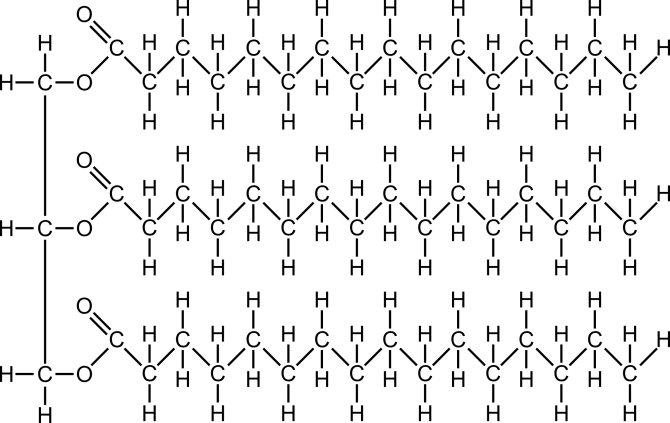
The chemical structure of fats has no common feature. They are a combination of triglycerides and their accompanying components. The proportion of triglycerides is 93-95%, the remaining percentage is other substances, including 0.03-0.05% water.
The lipid molecule contains residues of higher fatty carboxylic acids: stearic acid C17H35COOH, palmitic acid C15H31COOH, oleic acid C17H33COOH. There are also residues of lower acids such as butanoic acid (triglyceride of butyric acid).
